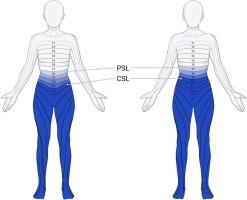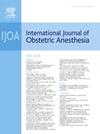Characterizing patterns of sensory loss during labor epidural analgesia: a prospective study of breakthrough pain
IF 2.3
3区 医学
Q2 ANESTHESIOLOGY
引用次数: 0
Abstract
Background
Two distinct levels of sensory loss can be detected while assessing the cephalad spread of epidural analgesia during labor: the level of complete sensory loss (cephalad dermatome with complete sensory loss to a testing stimulus) and the level of partial sensory loss (cephalad dermatome of partial sensation to the same stimulus). This study sought to determine the levels of complete and partial sensory loss in patients experiencing breakthrough pain and how they change after re-establishment of analgesia.
Methods
We conducted an exploratory prospective cohort study to compare the levels of complete and partial sensory loss, to both ice and pinprick, at a time when patients experienced breakthrough pain and after effective analgesia was re-established.
Results
We enrolled 30 patients. The median [interquartile range] level of complete sensory loss to ice increased from T12 [L1–T10] while in pain to T10 [T11–T9] after analgesia was re-established. The median level of complete sensory loss to pinprick increased from T12 [L2–T11] while in pain to T11 [T12–T10] after analgesia was re-established. The median level of partial sensory loss to ice and pinprick was above T10 both before and after top-up.
Conclusion
Patients experiencing breakthrough pain had a level of complete sensory loss to ice and pinprick below T10. After re-establishment of analgesia, the level of complete sensory loss to ice increased to T10 or above suggesting the level of complete sensory loss to ice may be the preferred mode of assessment of labor epidural analgesia to ensure optimal analgesia. Study registration: www.clinicaltrials.gov (NCT05881395); registered 31st May 2023.

分娩时硬膜外镇痛过程中感觉丧失的特征:突破性疼痛的前瞻性研究
背景:在评估分娩过程中硬膜外镇痛的头侧扩散时,可以检测到两种不同程度的感觉丧失:完全感觉丧失水平(对测试刺激完全感觉丧失的头侧皮肤区)和部分感觉丧失水平(对相同刺激部分感觉的头侧皮肤区)。本研究旨在确定突破性疼痛患者的完全和部分感觉丧失水平,以及它们在重新建立镇痛后如何变化。方法我们进行了一项探索性前瞻性队列研究,比较在患者经历突破性疼痛和重新建立有效镇痛后,冰敷和针刺时完全和部分感觉丧失的水平。结果共入组30例患者。冰致完全感觉丧失的中位[四分位数范围]水平从疼痛时的T12 [L1-T10]增加到重新镇痛后的T10 [T11-T9]。针刺时完全感觉丧失的中位水平从疼痛时的T12 [L2-T11]增加到重新镇痛后的T11 [T12 - t10]。充值前后冰和针刺部分感觉丧失的中位数均在T10以上。结论突破性疼痛患者T10以下为冰刺完全感觉丧失水平。重建镇痛后,对冰的完全感觉丧失等级升至T10以上,提示对冰的完全感觉丧失等级可能是分娩硬膜外镇痛的首选评估模式,以确保最佳的镇痛效果。研究注册:www.clinicaltrials.gov (NCT05881395);注册于2023年5月31日。
本文章由计算机程序翻译,如有差异,请以英文原文为准。
求助全文
约1分钟内获得全文
求助全文
来源期刊
CiteScore
4.70
自引率
7.10%
发文量
285
审稿时长
58 days
期刊介绍:
The International Journal of Obstetric Anesthesia is the only journal publishing original articles devoted exclusively to obstetric anesthesia and bringing together all three of its principal components; anesthesia care for operative delivery and the perioperative period, pain relief in labour and care of the critically ill obstetric patient.
• Original research (both clinical and laboratory), short reports and case reports will be considered.
• The journal also publishes invited review articles and debates on topical and controversial subjects in the area of obstetric anesthesia.
• Articles on related topics such as perinatal physiology and pharmacology and all subjects of importance to obstetric anaesthetists/anesthesiologists are also welcome.
The journal is peer-reviewed by international experts. Scholarship is stressed to include the focus on discovery, application of knowledge across fields, and informing the medical community. Through the peer-review process, we hope to attest to the quality of scholarships and guide the Journal to extend and transform knowledge in this important and expanding area.

 求助内容:
求助内容: 应助结果提醒方式:
应助结果提醒方式:


